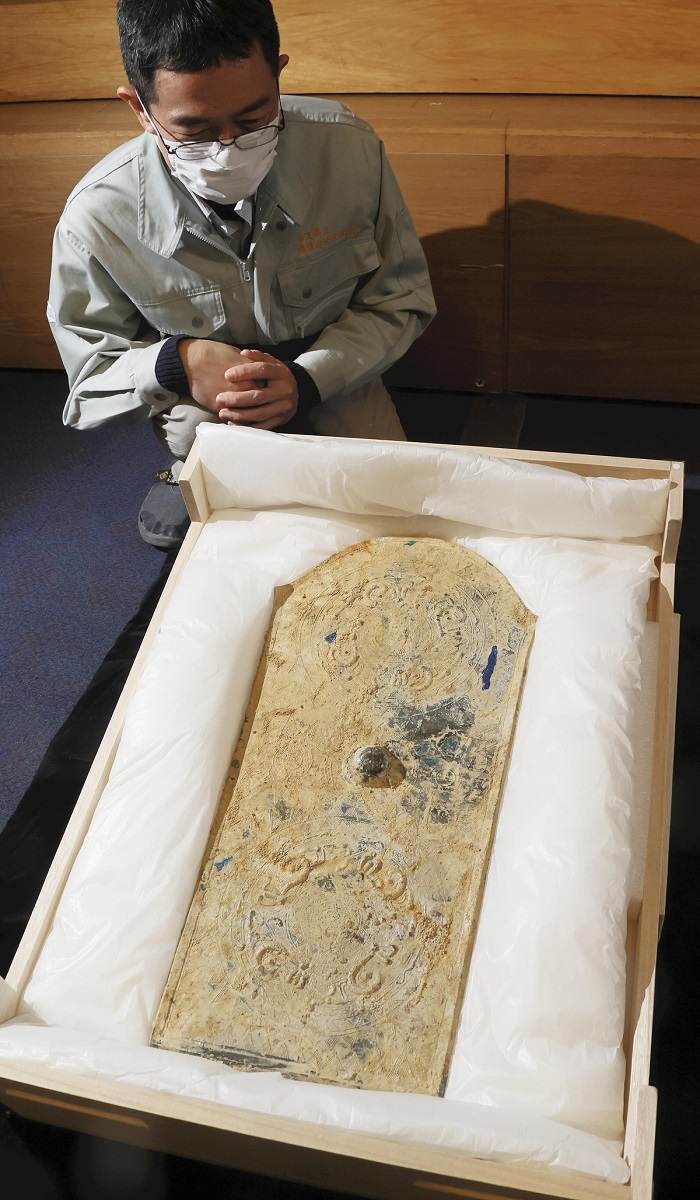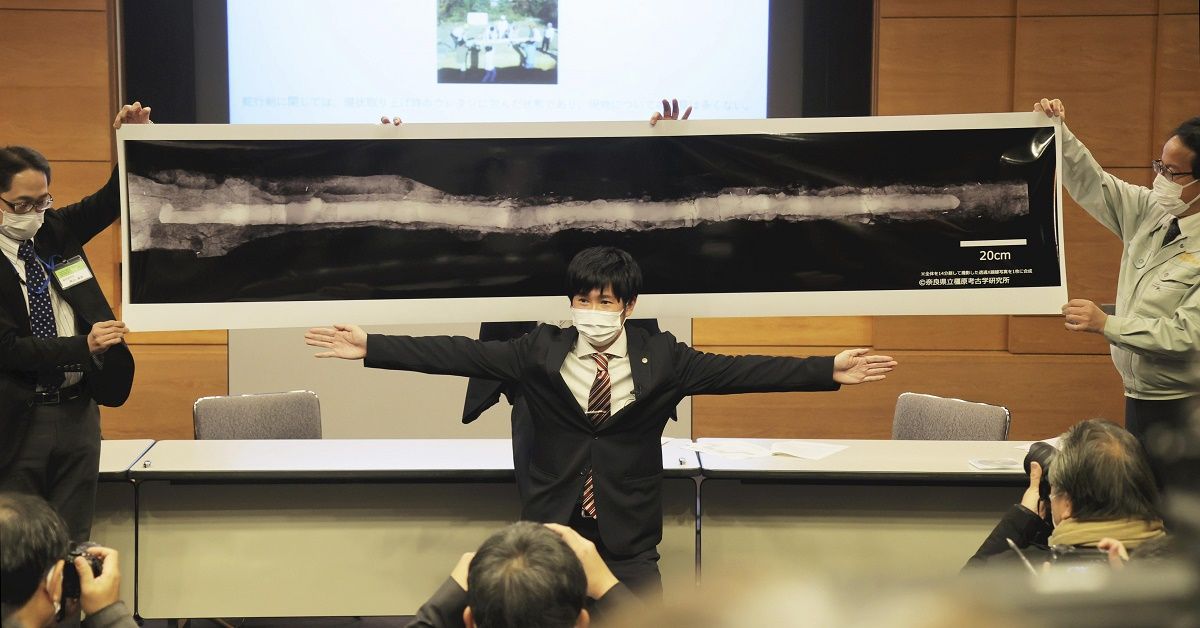Japan’s 1st Shield-Shaped Bronze Mirror, Huge Sword Unearthed from Ancient Burial Mound

The shield-shaped bronze mirror unearthed from an ancient burial mound in Nara is seen at the Archaeological Institute of Kashihara in Nara Prefecture.
13:20 JST, January 27, 2023
NARA — For the first time in Japan, a bronze mirror in the shape of a shield has been unearthed. It was found in the ancient capital of Nara along with the longest iron sword ever excavated in the nation, at 2.37 meters.
Both items were found in the ancient Tomio Maruyama burial mound, which is the largest circular one in Japan and has been dated to the latter half of the fourth century. The mirror and sword appear to have been domestically made.
The Nara prefectural Archaeological Institute of Kashihara and the Nara municipal board of education announced the discovery of these items Wednesday, describing them as “metalwork masterpieces from the Kofun period” that roughly spans the 3rd and the 7th centuries.
The mirror is 64 centimeters long, 31 centimeters at its widest and 5 millimeters at its thickest. Many such mirrors discovered have been round, with some square. The surface area also makes it the largest ancient bronze mirror found in Japan.
On the back of the mirror is a knob handle through which a cord could be attached. Above and below this knob are circular decorations with motifs of divinities and sacred animals. This pattern is similar to bronze mirrors with the design of divinities and dragons made in Japan during the Kofun period.
Along with these elements, the front had been polished, leading to the conclusion that this was a mirror.

An X-ray photo of an iron sword unearthed from an ancient burial mound in Nara is seen at the Archaeological Institute of Kashihara in Nara Prefecture.
“The combined function of a mirror that acts as a talisman against evil and of a shield indicates a firm intention to protect the buried person from external threats,” said Shimane University Associate Prof. Takashi Iwamoto, an expert on Kofun bronzes.
The iron sword has a 6-centimeter-wide serpentine blade and is significantly bigger than the previously longest 1.15-meter iron sword found in a burial mound in Hiroshima. This suggests advanced techniques were used to make the 2.37-meter sword.
The mirror and sword were unearthed in December from the northeast side of the Tomio Maruyama burial mound. The mound was built around the time the Yamato rulers were expanding their power.
Historical records of ancient China, however, make no mention of this time period, which has resulted in the fourth century being dubbed a “blank period.” Consequently, it is unknown who was buried in this mound. Experts believe the mirror and sword could be important archaeological materials that might help to unravel that mystery.
“These peculiar burial items were products from a period of major change,” said Kazuo Ichinose, professor emeritus of Kyoto Tachibana University. “I think the person buried there might have been the head of a local ruling family that had grown powerful and supported the Yamato rulers.”

Decorative patterns are seen in an X-ray photo of the shield-shaped bronze mirror.
"Society" POPULAR ARTICLE
-

M4.9 Earthquake Hits Tokyo, Neighboring Prefectures
-

M7.5 Earthquake Hits Northern Japan; Tsunami Waves Observed in Hokkaido, Aomori and Iwate Prefectures
-

Tsukiji Market Urges Tourists to Avoid Visiting in Year-End
-

Israeli Tourists Refused Accommodation at Hotel in Japan’s Nagano Pref., Prompting Protest by Israeli Embassy and Probe by Prefecture
-

M5.7 Earthquake Hits Japan’s Kumamoto Pref., Measuring Upper 5 Intensity, No Tsunami Expected
JN ACCESS RANKING
-

Keidanren Chairman Yoshinobu Tsutsui Visits Kashiwazaki-Kariwa Nuclear Power Plant; Inspects New Emergency Safety System
-

Imports of Rare Earths from China Facing Delays, May Be Caused by Deterioration of Japan-China Relations
-

University of Tokyo Professor Discusses Japanese Economic Security in Interview Ahead of Forum
-

Japan Pulls out of Vietnam Nuclear Project, Complicating Hanoi’s Power Plans
-

Govt Aims to Expand NISA Program Lineup, Abolish Age Restriction






















